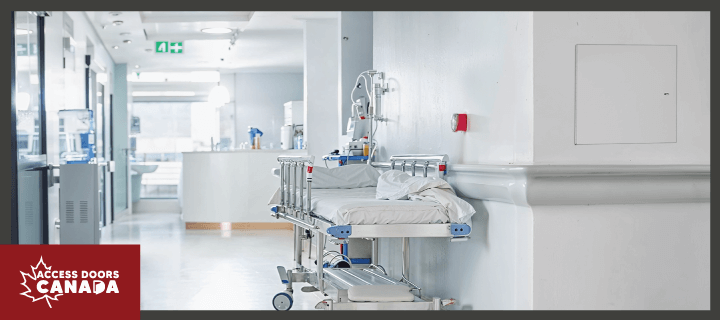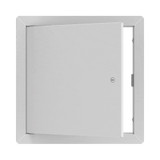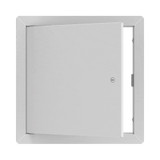How Insulated Access Doors Help Green Building Certifications in Canada
Sustainable building practices are essential in Canada's evolving construction landscape. LEED, administered by the CaGBC, is the recognized standard for demonstrating this commitment. It delivers high-performing, healthy, cost-effective green buildings. LEED certification means quality and sustainability for clients and the planet.
Access doors are crucial for LEED's energy efficiency and indoor environmental quality. Non-insulated access panels compromise the building envelope. This is particularly problematic in wall and ceiling applications where a consistent thermal barrier is critical. These issues impact a building's performance and hinder efforts to achieve LEED certification.
Insulated access doors offer a solution by incorporating high-performance insulation and airtight seals. These specialized access solutions minimize thermal transfer and air leakage, contributing to LEED credits. These doors enhance building performance and contribute to LEED certification when properly installed.
Understanding Insulated Access Doors for Walls and Ceilings
Let's get down to the nuts and bolts. What is an insulated access door, and why is it different from a standard access panel?
Like most access panels, an insulated access door provides easy access to concealed building services (like plumbing, electrical, or HVAC) while minimizing transfer and air leakage through the building envelope.
However, unlike standard access solutions, these doors are specifically engineered for installation in walls and ceilings, and they go beyond basic access. They're built with key features that contribute directly to a building's energy performance and indoor environmental quality:
- Insulation Types and R-Values: Insulated access doors have foam cores; higher R-values mean better heat flow resistance. In Canada's varied climate, appropriate R-values are crucial: R-10 or greater for exterior walls and R-5 to R-10 for interior ceilings. R-10 exterior wall access doors minimize winter heat loss and condensation, improving building performance over R-3 models.
- Airtight Seals and Gaskets: Airtight seals and gaskets on insulated access doors prevent air leakage and improve indoor air quality. Effective seals depend on the correct on-site installation of the frame, sealant, and gasket. Airtight plenum seals maintain healthy indoor air by blocking unfiltered air from wall cavities.
- Durable Materials: Long-term performance is key to sustainability. Insulated access doors should be constructed from durable materials that can withstand repeated use and resist corrosion. Aluminum, especially with recycled content, is a popular green building material in Canada due to its strength, lightweight, and recyclability.
The ADC-PAL Insulated Aluminum Access Door is a prime example of a product designed with LEED performance in mind. Durable aluminum, high-performance insulation, and continuous gasketing ensure superior air tightness, directly supporting LEED credits for energy efficiency and indoor environmental quality.
How Insulated Access Doors Contribute to LEED Credits
Now, let's discuss the bottom line: how insulated access doors translate into LEED points. These products contribute most significantly to the energy and atmosphere (EA) and indoor environmental quality (EQ) categories and potentially to materials and resources (MR).
Energy and Atmosphere (EA)
In LEED's Energy and Atmosphere (EA) category, insulated access doors are key to maximizing energy efficiency. Unlike standard, uninsulated panels, these doors meet the EA Prerequisite Minimum Energy Performance by preventing thermal bridging at wall and ceiling penetrations. Insulated access doors with higher R-values contribute to LEED's EA Credit Optimize Energy Performance by reducing heat flow and lowering energy costs and carbon footprint.
Indoor Environmental Quality (EQ)
Insulated access doors significantly contribute to the goal of healthy, comfortable indoor spaces in the Indoor Environmental Quality (EQ) category. Airtight insulated access doors minimize leakage, preventing pollutants and dust from entering conditioned spaces and contributing to the EQ Credit Enhanced Indoor Air Quality Strategies.
These doors improve thermal comfort (EQ Credit) by preventing drafts and stabilizing indoor temperatures, particularly in areas with extended occupancy. Insulated, airtight doors in negative-pressure environments prevent outside air and pollutants from entering, maintaining a controlled environment and enhancing occupant well-being.
Materials and Resources (MR)
While not always a primary MR contributor in LEED, insulated access doors can provide valuable benefits where applicable. Specifying recycled aluminum access doors contributes to MR material reuse credits. High-quality, insulated access doors minimize replacements, waste, and life-cycle costs, contributing to building sustainability.
Specifying and Installing Insulated Access Doors for LEED Projects
The real impact of insulated access doors on LEED projects comes down to proper specification and installation. A high-performance door won't deliver its full potential if not chosen and installed correctly.
For Architects and Designers
Architects and designers must consider location, purpose, dimensions, and insulation when specifying access doors and panels. Detailed drawings must clearly show access door locations, specifications, and frame-to-construction sealant/gasket details for airtight integration. LEED specifications must define R-values and air leakage rates and include performance testing.
For Contractors (Detailed On-Site Instructions)
Proper installation begins with correctly sized, plumb, and level framing for the access door. After applying sealant to the frame's back, we carefully insert and fasten it flush with the surrounding surface. Final hinge/latch adjustments and sealant application (if needed) ensure an airtight seal and optimal performance.
Proper specification and installation are essential for optimal performance. Insulated access door integration should consider climate, building type, and performance. Follow manufacturer instructions and ensure proper sealing and gasket compression for optimal installation. Recycled content and durable doors enhance sustainability and value.
On-Site Quality Control Checklists
Use a checklist to verify the proper installation:
- The frame is plumb and level.
- A continuous sealant bead is applied.
- The gasket is properly compressed.
- The door operates smoothly.
- There are no visible gaps or air leaks.
Troubleshooting Common Installation Issues
- Air leaks: Recheck the sealant application and gasket compression if leaks are detected. Apply more sealant if necessary.
- Door does not close properly: Adjust the hinges or latch to ensure proper alignment and closure.
- Frame not flush: Loosen the frame fasteners and adjust the frame until it is flush with the surrounding surface.
Access Doors Canada can provide valuable technical support and installation guidance. For assistance, please visit our website or call our representatives at 800-679-3405.
Conclusion
Though often perceived as minor details, insulated access doors are crucial for achieving green building certifications like LEED in Canada. They are integral to a high-performing and sustainable building envelope. Minimizing thermal bridging and air leakage enhances energy efficiency, lowering HVAC loads and operating costs.
With Access Doors Canada, you can maximize your LEED points and ensure project success. Contact us today to discuss your project requirements and request a quote before budgets tighten.









